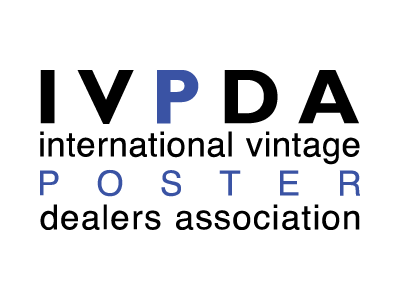Glossary: Prints and Posters
CMYK
- In the printing process there are four main colors used. CMYK is the abbreviation color inks used in this color model, cyan, magenta, yellow, and key (black)
Lithograph
- In the lithographic process, ink is applied to a grease-treated image on the flat printing surface; non-image (blank) areas, which hold moisture, repel the lithographic ink. This inked surface is then printed—either directly on paper, by means of a special press (as in most fine-art printmaking), or onto a rubber cylinder (as in commercial printing). The lithographic process is also a one-color process meaning that one color is placed, the print is made, the surface is cleaned, and then the next color is placed and so on and so forth until all four colors are finished
Serigraph (screen print)
- Screen-printing, also called serigraphy, is a stenciling technique used for surface printing. A design is cut out of thin, strong material and placed on silk, which is then placed on an aluminum or wood frame. Rubbing, rolling, or spraying paint or ink through the cut out areas in turn produces an image. To make a screen print, the wooden frame holding the screen is attached to a larger wooden board, the image is then placed on the board under the screen, and the paint is pressed through with a squeegee. This printing method, like the lithographic process, is also a one-color process
Etching
- Etching is a printing method that requires the use of a metal plate, usually copper, into which the design has been incised by acid. The plate is first coated with and acid-resistant substance, called the etching ground, through which the design is drawn with a sharp tool. The plate is then exposed to nitric acid, which eats away those areas of the plate unprotected by the ground leaving a pattern of lines. These lines hold the ink when applied to moist paper, resulting in the transferring of the design onto the paper
Offset Lithograph
- Common printing technique in which an inked image on a printing plate is printed on a rubber cylinder and then transferred to paper or other material. This printing method is a four-color process meaning, unlike with lithographs or serigraphs, all four colors are printing with one pass
Woodblock
- Woodblock print, or woodcut, is a relief printing technique used in printmaking in which an artist cuts along the grain carving out an image from the surface of a block of wood. The areas cut away by the artist carry no ink while the remaining design at surface level is inked to produce an image. This is also a one-color process
Linocut
- Linocut is a printing technique identical to woodcut only instead of carving out wood; the artist carves out of sheets of linoleum
Mixed Media
- Mixed media is a term used to describe visual art pieces that combine traditionally distinct visual art media – for example work that combines ink, charcoal, and collage
Foil Print
- Foil stamping, or foil print, is a commercial printing process involving the application of metallic or pigmented foil to a solid surface using heat
Watercolor
- Watercolor is a painting method in which the paints are made of a water-based solution. The term “watercolor” denotes both the medium and the resulting artwork
Giclée
- Giclée is a term used to describe fine art digital prints made on inkjet printers. This is also a four-color process
A/P (Artist Proof)
- Artists proofs, or printers proofs, is a term used to denote either a proof made for the printer to see how the image is printing or a final impression the printer is allowed to keep
Heliogravure
- Heliogravure, or photogravure, is a printmaking process whereby a copper plate is coated with light sensitive gelatin tissue that has been exposed to a film positive and then etched. The result is a high quality intaglio print that maintains the detail and continuous tones of a photograph
TP (Trial Proof)
- Trial proof, also called BAT for bon à tirer, is the term for the proofs that are created before the production run. Their function is to ensure that the proof is being created properly
Printer Proof
- Printer’s proofs, like trial proofs and artist’s proofs, serve as an agreement between the customer and the printer. Their primary goal is to ensure the entire job is accurate. Printer’s proofs are color reference guides for adjusting the press before the final run. Printer’s proofs generally make up no more than 10% of the total number of the edition
Signed
- The word signed designates a proof that has been signed by the artist. Proofs can be signed by hand, by stamp (a facsimile signature), or on the printing plate directly
Numbered
- Each print may be signed and numbered by the artist. Generally there are two numbers separated by a slash (Ex. 3/10). The larger number designates the total number of impressions and the smaller number identifies the specific print within the set. Prints are not signed and numbered in the order they were printed meaning a lower number print doesn’t have more value than a higher number. Prints may be numbered by hand directly, on the printing plate, or with a stamp
Limited Edition
- Limited edition prints are prints within an edition where the number of prints made and sold is limited to a specific number
Exhibition Poster
- An exhibition poster is a large printed picture or photograph containing text used to advertise an exhibition
Re-strike
- Re-strike is a term used to describe any print made that was not part of the original print run
Triptych
- Triptychs are pictures or carvings on three panels typically arranged side by side
Diptych
- Diptychs are pictures or carvings on two panels typically arranged side by side

